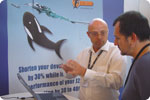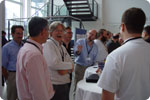SymposiaThe conference is organised as three parallel symposia on each of Monday and Tuesday. Each symposium has a theme and a fixed structure. We start with an introductory talk. If you don't need an introduction to your preferred symposium you can take the opportunity to sit in on an introduction to one of the subjects with which you are less familiar. The symposium continues with expository talks from speakers that are intimately familiar with the subject, either because they built it, or because they are experienced users of it. We conclude the symposium with a panel discussion: Here's where the experts can challenge each other on the direction the industry is taking - or should be taking. We'll be looking at how developments in J2EE (Java 2 Enterprise Edition) support programming in the large, and how networks of interacting object-oriented systems can be made robust and secure while giving you the performance you need today and tomorrow. 

|
Scalable and Grid Computing (J2EE)This symposium is about what it takes to build an architecture that scales to large applications. If your problem domain needs large numbers of CPUs and large numbers of machines you need to build a software system that can take advantage of 'big iron' hardware or grid computing - an application that distributes itself without getting bogged down by communications overhead or performance bottlenecks. Mobile ComputingHow to deliver the power and benefits of object-oriented technology to the exploding world of con-sumer and embedded devices? Systems in cars, phones and handhelds need a flexible user interface, a robust security model, and support for networked and disconnected applications. Learn how to build mobile and embedded applications - downloading them dynamically, and making optimal use of each device's native capabilities. Software Process Improvement (SPI)With the rise of "agile" and lightweight programming methods such as eXtreme Programming this symposium takes a look at where the new paradigms stand in relation to more traditional models as exemplified by CMMI, the latest revision of the Capability Maturity Model. Does the disciplined approach of CMMI conflict with the agility needed when developing network-based systems of of interlocking services, and can agile development methodologies scale to projects with several hundred or even thousand developers? Is it possible to combine both SPI directions for a best-of-both-worlds synthesis? We'll be hearing from experts from both sides of the divide, if indeed there is one! |
Model Driven Architecture (MDA)Object-oriented design focuses on building a model of the application domain from which we can generate the application. Ideally, we build a model in UML, refining it until we reach the point where code can be generated - perhaps even automatically. In this symposium we’ll be looking at how far the model-driven approach can take us, where it stands relative to code-driven approaches and how to resolve the apparent conflict between making development iterative and having the final goal in mind. SOA - Service-Oriented ArchitecturesThis symposium is about the movement of the ubiquitous SAP platform towards a service-oriented model where the previous 'closed world' of the mono-lithic application server is opened up with a multitude of externally accessible services based on object-oriented open standards. The talks will look at the requirements for flexibility and resiliency imposed by a services oriented architecture, and how enterprise application platforms can be adapted to a new open structure. Tiger Release (J2SE)J2SE version 1.5 ("Tiger") is the next major revision of the Java platform and language. Currently in beta testing, it is slated to contain 15 component JSRs and nearly 100 other significant updates developed through the Java Community Process. |
|
|








